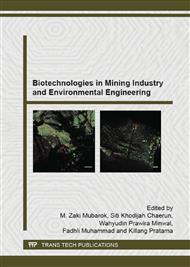p.3
p.7
p.11
p.15
p.19
p.23
p.28
p.32
Comparative Genomics Underlines the Functional and Taxonomic Diversity of Novel “Ferrovum” Related Iron Oxidizing Bacteria
Abstract:
Although acidophilic iron oxidizing bacteria related to “Ferrovum myxofaciens” P3G have been detected in various mining sites the knowledge about their physiology is limited to the type strain “F. myxofaciens” P3G. In order to further the knowledge on the metabolic capacity of “Ferrovum” related iron oxidizers we conducted a comparative genome analysis of three “Ferrovum” strains: JA12, PN-J185 and Z-31 (Z-31). The results of the phylogenetic analysis and the genome-to-genome distance calculation indicate that Z-31 belongs to a different “Ferrovum” species than JA12 and PN-J185. Comparative genome analyses revealed variations regarding the carbon, nitrogen and energy metabolism of the three strains which also corroborate the results concerning their phylogenetic relationship.
Info:
Periodical:
Pages:
15-18
Citation:
Online since:
November 2015
Price:
Сopyright:
© 2015 Trans Tech Publications Ltd. All Rights Reserved
Share:
Citation:


